
Wine Culture and Information since 2002 - Volume 22
 Wine Culture and Information since 2002 - Volume 22 |
|
Issue 206, May 2021 |
Contents |
|
|
Frosty April |
|
Spring, for those involved in agriculture, and therefore in viticulture, is that season which brings with it the renewed hope of rebirth, but also the fear of nefarious events which could transform that rebirth into an anticipated death. In some cases, moreover, these unfortunate events directly cause the non-rebirth. Anyone involved in agriculture is always forced to check, often with a certain apprehension, what happens both “in heaven” and “on earth”, as good and bad news can come from both sides. The only certainty is that – in the case of “bad news” – you will have to try to remedy or prevent, as far as possible, by saving everything that can be saved. It is not always possible to remedy, therefore, those who cultivate the land are not always able to harvest the fruit of their work. Furthermore, by considering those who “work the land” legitimately wish for the “fruits” in the form of economic profits, the loss and regret are double. April, the month that should express spring in its splendor of flowers and mild temperatures, can sometimes – unfortunately – bring bad surprises and, when Mother Nature bestows them this month, the consequences are serious and worrying. Indeed, among the fearsome events of April there are sudden and significant drops in temperature, hence the real risk of frosts. This phenomenon, in fact, directly affects the young shoots of plants, which – fragile and defenseless – are irreparably damaged, often causing their “death” as well. Without buds, of course, there will be no flowers, without flowers there will be no fruit. In some circumstances, and depending on the moment in which the frost occurs, the plant stubbornly tries again to generate new shoots, a condition that is always and in any case dependent on the course of the meteorological conditions of spring. New shoots which, however, do not have the “productive strength” of those lost because of the frost, but – as they say – it is always better than nothing. In recent days, the images from France, indeed, from French vineyards, have hit the news and arising a particular interest. The news has been particularly made spectacular by the aerial images that showed the controlled fires inside the vineyards with the aim of contrasting the terrible effects of the April frost. The expedient – certainly suggestive and that no vintner would like to see – aims to create a layer of smoke above the vineyard in order to limit and avoid the effects of the icy temperature. By looking at them, those images coming from France, gave the impression that a huge area of vineyards were in flames, in reality, they were simply trying to limit the damage by means of a show that no vintner would like to attend. In general terms, this expedient is effective in limiting possible future damage to fragile and young shoots – trusting in Mother Nature's clemency – and it is completely ineffective for those who, unfortunately, have already been damaged by the frost. The spectacular aerial images of French vineyards almost made us ignore what, no less worrying, has happened in Italy. In fact, April has also been very severe with Italian vineyards and, more generally, with the entire agricultural activities of the country. It is not my intention – of course – to diminish the severity of the frosts that hit the vineyards of France, as French vintners have suffered enormous damages because of the frosts, with an estimated destruction of the vineyards between 50 and 80%. The first estimates, in fact, amount to about two billion euros in damages and the French government, with commendable promptness, has already allocated one billion euros to support vintners and farmers. Also in Italy the frosts in April produced significant damage and losses and, according to Confagricoltura (a national confederation of farmers), the estimate currently amounts to one billion euros. The implicit invitation is for the effective and immediate intervention of the competent political authorities which will hopefully and promptly take appropriate actions to support Italian farmers and vintners. One would say “it never rains but it pours”. The critical condition of the Italian wine trade – already severely hit by the economic consequences produced by the Covid-19 pandemic – would be further aggravated by the risk of losses in the 2021 season. The consequences of Brexit – the United Kingdom's exit from the European Union – with the consequent procedures of bureaucratic and administrative constraints, according to the Centro Studi Divulga, have already caused a 36% decrease in wine exports. This is not good news – in my opinion, not even for the citizens of the United Kingdom, as their exports have dropped as well – as this country represents one of the most important foreign markets for Italian wineries. The frosts in April have therefore further contributed to the worsening of future market opportunities for Italian wine, by also considering that – in certain areas – it is estimated the loss of several thousand hectares of vineyards. Not only vineyards, of course, as the loss and damage have affected the entire agricultural sector with an estimate of damage to production ranging between 80 and 90%. In this regard – and by specifically considering the condition of the vineyards in Italy – the damage caused by the frosts occurred in limited areas, however extended throughout the Italian territory. In particular, according to initial estimates, the vineyards that suffered the most damage are those located in the mid-hill and valley floor areas, mainly destroying the buds of the early ripening varieties. Among the regions to report the most important damage are Umbria and Tuscany as well as some territories of Emilia-Romagna and Veneto. The southern regions are among the least affected ones. While hoping there will be no further consequences, and while waiting for more in-depth checks, no significant decreases in wine production are expected in Italy – according to the farmer and vintner associations –, with the exception, unfortunately, of the most affected areas. It is the repetition of the cycle of the seasons, always carrying with it the unpredictability and, sometimes, the inevitable consequences of certain negative events. In fact, Mother Nature is not always merciful and magnanimous with those who live between heaven and earth. In some cases – let's not forget this – it is man who conditions and alters the cycle and stability of natural events, in others it is simply the course of Nature and for which, very often, we are unarmed, suffering the extreme consequences without any possibility of intervention. Nature gives, Nature takes away. This is something known very well – and they find this out for themselves – by those who work the land and from the land trust to harvest the fruits of their labor. This is not, of course, a passive conclusion to the resignation of having to undergo the whims of Mother Nature's fate, it simply is the evidence of a possible risk. As always, we must wait for the end of the harvest and after that – and only after that – we can breathe a liberating sigh of relief by raising the glass and making a toast to the good luck and the good job done. And also to Mother Nature. Antonello Biancalana
|
||||
Contrasts of Est! Est!! Est!!! di Montefiascone and Vermentino di Gallura SuperioreOne of the most ancient wines of Latium compared to the famous white of Sardinia, the only Denomination of Controlled and Guaranteed Origin wine of the island |
|
Sensorial wine tasting is a rigorous exercise that can be defined, undoubtedly, endless and renewed with each glass. Given the number of grapes used for the production of wines, the territorial interpretation that each of these offers in the various countries of the world, not least, the union of several grapes and territories for the creation of a single wine, the combinations are considerable, endless. The sensorial evaluation of wine – thanks to the huge number of combinations, countless elements and factors – requires an enormous level of experience made of countless thousands of different tastings and each of them to be treasured for future reference. In this sense, Italy has an extraordinary wine heritage which is unique in the world. The richness of the indigenous varieties spread throughout the territory, to which are added the international grapes cultivated in all regions, as well as the enormous variety of environmental and cultural conditions, offer the taster endless and precious possibilities of study. The same grape, in fact, gives different results, sometimes even distant, depending on the place of cultivation. One of them, undoubtedly, is Vermentino – a grape used for the production of one of the two wines of this month's tasting by contrast – found in different regions of Italy and making distinct and distant results in each of them. Likewise, it is very interesting, as an opportunity to study, the evaluation of those wines produced with the blending of many grapes – an excellent example is the other wine of this month's tasting – in which the overall profile is the union of all the varieties according to the specific expression of the territory. This therefore means the same varieties grown and vinified in different places produce different wines. The wines we will examine this month are a mono-varietal, that is produced with just one grape, specifically, Vermentino di Gallura Superiore, compared to a multi-varietal wine, therefore produced with more grapes, that is the famous Est! Est!! Est!!! di Montefiascone. Two wines extremely different in every sensorial aspect, in particular in the olfactory and gustatory expressions.
|
|
The famous white wine of Montefiascone – in Latium, in the province of Viterbo – got its fame because of the famous events that saw the German bishop Johannes Defuk and his trusted servant Martino as protagonists. The story tells that Bishop Defuk had a strong predilection for good wine and, in 1111, on the occasion of the coronation of Henry V of Germany as Emperor of the Holy Roman Empire by Pope Paschal II, he traveled the Via Francigena to reach Rome. As the journey was quite long, it was necessarily divided into numerous stages, and Bishop Defuk was preceded by his servant Martino, who had the task of evaluating the wines produced in the various locations along the Via Francigena and by signaling the best ones so that the bishop had the certainty of always having “good wine” along the way. They agreed on a simple signal: if the servant Martino found good wine in an inn, he should have signaled the good quality by writing the Latin word est (that is “is”) at the entrance, meaning, in that case , the abbreviation for “est bonum” (it is good). If the wine was very good, he should have signaled it with “est est'. The story has it that, when the servant Martino arrived in Montefiascone, he found the local wine so good that it deserved a triple mention, therefore “Est! Est!! Est!!!”, underlining the exceptional quality with exclamation marks. Bishop Defuk – so the story goes – was equally surprised by the wine of Montefiascone, so much so that he decided to extend his stay to three days. Moreover, during the return journey, he decided to stop and settle in Montefiascone, where he died in 1113 – it is said – because of the excessive consumption of local wine, most likely moscatello wine, and here he was buried in the church of San Flaviano. However, regardless of this story – that for many it is a legend, a combination of reality and fantasy – the production of wine in Montefiascone has very ancient origins and dating back to the times of the Etruscans. From an enological point of view, Est! Est!! Est!!! di Montefiascone – wine recognized as Denomination of Controlled Origin, DOC – is produced with Trebbiano Toscano, locally called Procanico, from 50 to 65%; Trebbiano Giallo, here known as Rossetto, from 25 to 40%; Malvasia Bianca Lunga and/or Malvasia del Lazio from 10 to 20%. Usually vinified in inert containers, Est! Est!! Est!!! di Montefiascone is usually a medium-bodied wine and generally suitable for immediate consumption.
|
||||
|
In the enological scenario of Sardinia, talking about white grape varieties, the absolute glory is undoubtedly Vermentino. Grape capable of making wines of amazing class and elegance, Vermentino is cultivated throughout the region, widely used for the production of the island's whites and for which exist two denominations that provide it as the only protagonist: Vermentino di Sardegna and Vermentino di Gallura. The first is a Denomination of Controlled Origin and is permitted in the entire region; the second represents the only Denomination of Controlled and Guaranteed Origin (DOCG) in Sardinia and is produced in the Gallura area, in the north-eastern part of the island. In Gallura, in fact, Vermentino expresses itself with a strong personality, giving wines of good structure and having a remarkable finesse, crispness and elegance, as well as an important quantity of alcohol by volume, it expresses itself with a unique character that clearly distinguishes it from other wines produced with same grape in other territories. Vermentino is not an indigenous grape of Sardinia and its land of origin is probably the territory of Aragon, in Spain, where it was probably known by the name Listan, although it has not been cultivated here for a long time. According to other hypotheses, it may have originated in Portugal where it is known by the name of Codega. It arrives in Sardinia after a long journey that sees it first crossing the southern part of France, then Liguria, and then reaching Corsica and finally Sardinia. A grape of considerable enological versatility and capable of many styles, in Gallura it is mainly appreciated for its dry wines, especially for those produced in inert containers, a characteristic enhancing both crispness and the expression of its elegant aromas. In this regard, it should be noted – confirming the interesting versatility of Vermentino – that some producers in Gallura also use cask or barrique, therefore accentuating the structure and roundness of the wine. Even in these cases, however, Vermentino di Gallura expresses its typical crispness and pleasing olfactory personality.
|
Before starting this month's tasting by contrast, let's proceed with choosing the two wines to be poured into the glasses. The availability is very wide as they are – in both cases – widely produced wines and therefore easily available both in specialized wine shops and in large-scale distribution. In both cases we will pay attention to the winemaking technique used for the fermentation and aging, by choosing wines completely produced in inert containers, such as the steel tank. As for the composition, we will not have any freedom of choice. Est! Est!! Est!!! di Montefiascone is in fact always and mainly produced with Trebbiano Toscano, followed by Trebbiano Giallo and, finally, a small amount of Malvasia Bianca Lunga and/or Malvasia del Lazio. As for Vermentino di Gallura Superiore, although the relative production disciplinary provides for the presence of the homonymous grape for 95%, almost all producers choose to use this variety alone. The two wines belong to the latest harvest and will be tasted at a temperature of 10 °C. (50 °F) Let's pour the Est! Est!! Est!!! di Montefiascone and Vermentino di Gallura Superiore in their respective tasting glasses and let's proceed with the sensorial evaluation, starting with the appearance of the wine from Latium. Let's tilt the glass over a white surface – a sheet of paper is enough – and observe the wine at the base. The color of the Est! Est!! Est!!! di Montefiascone is generally pale straw yellow, often greenish yellow, with a high transparency. The nuance of this wine, observed at the edge, near the opening of the glass, reveals a greenish yellow color. Let's now pass to the evaluation of the appearance of Vermentino di Gallura Superiore and, just like for the previous wine, we tilt the glass over the white surface. From the observation of the base of the glass, the Sardinian wine reveals a bright straw yellow color, generally more intense than the wine from latium, with a high transparency. The nuance, observed towards the opening of the glass, reveals and confirms the straw yellow color. The olfactory profiles of the Est! Est!! Est!!! di Montefiascone and Vermentino di Gallura Superiore reveal enormous differences to the nose. Not only for a merely productive fact – the wine from Latium is always multi-varietal, the Sardinian wine is practically a mono-varietal in all cases – but above all, and as it can be easily understood, for the specific sensorial qualities of the grapes making it. The olfactory profile of the Est! Est!! Est!!! di Montefiascone is mainly determined by Trebbiano Toscano and Trebbiano Giallo, to which is added the gentle aromatic quality of Malvasia Bianca and/or Malvasia del Lazio. In this wine are mainly perceived aromas of white pulp fruits, as well as yellow and white flowers, which are sometimes combined with sensations of tropical fruit and citrus. The profile of Vermentino di Gallura Superiore has a fuller and more expressive olfactory character, in which can be recognized white and yellow pulp fruits, as well as yellow and white flowers, often aromatic herbs and tropical fruit, sometimes characterized by a pleasing touch of bitter almond, typical in many wines produced with Vermentino. Let's resume the tasting by contrast of this month and proceed with the evaluation of the olfactory profiles of the two wines. The first wine we will examine – just like the previous phase – is Est! Est!! Est!!! di Montefiascone. Let's hold the glass in vertical position and, without swirling, let's proceed with the first smell in order to appreciate the opening aromas, that is the olfactory qualities that mainly identify a wine. From the glass we perceive pleasing and intense aromas of apple, pear and hawthorn. Let's now swirl the glass, an operation that will favor the oxygenation and therefore the development of the remaining aromas, and let's proceed with the second smell. The wine from Latium is completed with plum, broom, peach, citrus and, sometimes, a hint of exotic fruit in which can be recognized pineapple. Let's now pass to the evaluation of the aromas in Vermentino di Gallura Superiore and let's do the first smell in order to evaluate its opening. In the Sardinian wine can be perceived intense and pleasing aromas of apple, peach, pear and hawthorn. After having swirled the glass and carried out the second smell, Vermentino di Gallura Superiore is completed with plum, broom, citrus fruits, anise, medlar and pineapple as well as the characteristic hint of bitter almond. Let's now proceed to the evaluation of the gustatory profiles of our wines, taking into consideration, like in the previous phases, Est! Est!! Est!!! di Montefiascone. The first examination that we will carry out is about the evaluation of the attack, that is the primary gustatory sensations the wine expresses in the mouth. Let's take a sip of this wine: its attack is characterized by the pleasing crispness given by acidity, getting its balance with the effect of alcohol that, in Est! Est!! Est!!! di Montefiascone, is about 13% by volume. The perception of the structure is of medium intensity, never excessive, and in the mouth we perceive the flavors of apple, pear and plum. Let's now pass to the evaluation of the attack of Vermentino di Gallura Superiore and let's take a sip. In the mouth can be perceived a good and pleasing crispness given by acidity, also in this case, well balanced by the effect of alcohol, generally having a volume higher than that of the wine from Latium. The perception of the structure is definitely fuller than in Est! Est!! Est!!! di Montefiascone and in the mouth we perceive, intense and pleasing, the flavors of apple, pear and peach, as well as a pleasing hint of bitter almond. Let's conclude this month's tasting by contrast by evaluating the final sensations the two wines leave in the mouth after swallowing. The finish of Est! Est!! Est!!! di Montefiascone is of good persistence, leaving in the mouth a pleasing sensation of crispness as well as of moderate structure, with an overall character of immediate wine and of pleasing consumption. Moreover, we can continue perceiving flavors of apple, pear and plum. The finish of Vermentino di Gallura Superiore is persistent, leaving in the mouth pleasing and intense flavors of apple, pear and peach which are often followed by the characteristic slightly bitter flavor in which can be recognized bitter almond. In this wine is also perceived the pleasing sensation of crispness and the good structure, the latter being more intense – even in the final phase – when compared to the wine from Latium. Before ending the tasting, let's place the two glasses side by side, without swirling, and let's carry out the last analysis of the olfactory opening: the differences in the profiles continue to express themselves with evident distance.
|
||||||||
Wines of the Month |
|
|
|
Score legend Prices are to be considered as indicative. Prices may vary according to the country or the shop where wines are bought |
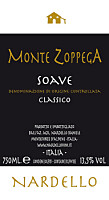
|
|
Soave Classico Monte Zoppega 2017 |
|
| Nardello (Veneto, Italy) | |
 Garganega Garganega | |
| Price: € 18.00 | Score: |
 Intense straw yellow and nuances of straw yellow, very transparent. Intense straw yellow and nuances of straw yellow, very transparent. Intense, clean, pleasing and refined, starts with hints of apple, plum
and grapefruit followed by aromas of hawthorn, broom, chamomile, melon,
pear, peach and almond. Intense, clean, pleasing and refined, starts with hints of apple, plum
and grapefruit followed by aromas of hawthorn, broom, chamomile, melon,
pear, peach and almond.
 Crisp attack and however balanced by alcohol, good body, intense
flavors, pleasing roundness. Crisp attack and however balanced by alcohol, good body, intense
flavors, pleasing roundness.
 Persistent finish with flavors of apple, plum and grapefruit. Persistent finish with flavors of apple, plum and grapefruit. 7 months in barrique. 7 months in barrique. |
|
 Stuffed pasta with mushrooms, Roasted white meat, Roasted fish, Stewed fish with mushrooms Stuffed pasta with mushrooms, Roasted white meat, Roasted fish, Stewed fish with mushrooms |
|
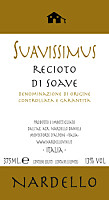
|
|
Recioto di Soave Suavissimus 2016 |
|
| Nardello (Veneto, Italy) | |
 Garganega Garganega | |
| Price: € 25.00 - 375ml | Score: |
 Brilliant amber yellow and nuances of amber yellow, transparent. Brilliant amber yellow and nuances of amber yellow, transparent. Intense, clean, pleasing and refined, starts with hints of raisin,
quince jam and hazelnut followed by aromas of dried fig, candied fruit,
date, citrus fruit peel, honey, almond and hints of vanilla. Intense, clean, pleasing and refined, starts with hints of raisin,
quince jam and hazelnut followed by aromas of dried fig, candied fruit,
date, citrus fruit peel, honey, almond and hints of vanilla.
 Sweet and round attack, however balanced by alcohol, good body, intense
flavors, pleasing crispness. Sweet and round attack, however balanced by alcohol, good body, intense
flavors, pleasing crispness.
 Persistent finish with flavors of raisin, quince jam and honey. Persistent finish with flavors of raisin, quince jam and honey. Fermented and aged in barrique. Fermented and aged in barrique. |
|
 Confectionery, Dried fruit tarts Confectionery, Dried fruit tarts |
|

|
|
Moscato d'Asti Canelli 2020 |
|
| L'Armangia (Piedmont, Italy) | |
 Moscato Bianco Moscato Bianco | |
| Price: € 9.00 | Score: |
 Brilliant greenish yellow and nuances of greenish yellow, very
transparent. Brilliant greenish yellow and nuances of greenish yellow, very
transparent.
 Intense, clean, pleasing and refined, starts with hints of grape, peach
and banana followed by aromas of peach, white rose, sage, broom, tangerine,
apple and pear. Intense, clean, pleasing and refined, starts with hints of grape, peach
and banana followed by aromas of peach, white rose, sage, broom, tangerine,
apple and pear.
 Sweet and crisp attack, however balanced by alcohol, light body,
intense flavors, agreeable. Sweet and crisp attack, however balanced by alcohol, light body,
intense flavors, agreeable.
 Persistent finish with flavors of grape, peach and banana. Persistent finish with flavors of grape, peach and banana. Fermented in closed tank. Fermented in closed tank. |
|
 Cream and fruit desserts Cream and fruit desserts |
|

|
|
Nizza Riserva Vignali 2016 |
|
| L'Armangia (Piedmont, Italy) | |
 Barbera Barbera | |
| Price: € 24.00 | Score: |
 Deep ruby red and nuances of ruby red, little transparency. Deep ruby red and nuances of ruby red, little transparency. Intense, clean, pleasing, refined and elegant, starts with hints of
cherry, plum and blueberry followed by aromas of dried violet, raspberry,
blackberry, cocoa, tobacco, leather, tamarind, cinnamon, mace, vanilla and
menthol. Intense, clean, pleasing, refined and elegant, starts with hints of
cherry, plum and blueberry followed by aromas of dried violet, raspberry,
blackberry, cocoa, tobacco, leather, tamarind, cinnamon, mace, vanilla and
menthol.
 Properly tannic attack and however balanced by alcohol, full body,
intense flavors, pleasing crispness. Properly tannic attack and however balanced by alcohol, full body,
intense flavors, pleasing crispness.
 Persistent finish with flavors of cherry, plum and blueberry. Persistent finish with flavors of cherry, plum and blueberry. 12 months in barrique, at least 12 months in cask. 12 months in barrique, at least 12 months in cask. |
|
 Game, Roasted meat, Stewed and braised meat, Hard cheese Game, Roasted meat, Stewed and braised meat, Hard cheese |
|
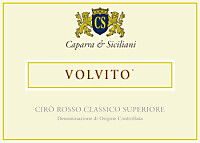
|
|
Cirò Rosso Classico Superiore Riserva Volvito 2016 |
|
| Caparra & Siciliani (Calabria, Italy) | |
 Gaglioppo Gaglioppo | |
| Price: € 11.50 | Score: |
 Brilliant garnet red and nuances of brick red, moderate transparency. Brilliant garnet red and nuances of brick red, moderate transparency. Intense, clean, pleasing and refined, starts with hints of prune, black
cherry and dried violet followed by aromas of strawberry jam, dried rose,
tobacco, cocoa, licorice, mace, vanilla and menthol. Intense, clean, pleasing and refined, starts with hints of prune, black
cherry and dried violet followed by aromas of strawberry jam, dried rose,
tobacco, cocoa, licorice, mace, vanilla and menthol.
 Properly tannic attack and however balanced by alcohol, good body,
intense flavors, agreeable. Properly tannic attack and however balanced by alcohol, good body,
intense flavors, agreeable.
 Persistent finish with flavors of prune, black cherry and strawberry
jam. Persistent finish with flavors of prune, black cherry and strawberry
jam.
 Aged in barrique. Aged in barrique. |
|
 Roasted meat, Stewed meat with mushrooms, Broiled meat and barbecue Roasted meat, Stewed meat with mushrooms, Broiled meat and barbecue |
|

|
|
Mastrogiurato 2016 |
|
| Caparra & Siciliani (Calabria, Italy) | |
 Gaglioppo, Greco Nero Gaglioppo, Greco Nero | |
| Price: € 13.50 | Score: |
 Brilliant garnet red and nuances of garnet red, moderate transparency. Brilliant garnet red and nuances of garnet red, moderate transparency. Intense, clean, pleasing, refined and elegant, starts with hints of
plum, black cherry and dried violet followed by aromas of blueberry,
raspberry, cocoa, leather, licorice, tobacco, cinnamon, vanilla and
menthol. Intense, clean, pleasing, refined and elegant, starts with hints of
plum, black cherry and dried violet followed by aromas of blueberry,
raspberry, cocoa, leather, licorice, tobacco, cinnamon, vanilla and
menthol.
 Properly tannic attack and however balanced by alcohol, good body,
intense flavors, agreeable. Properly tannic attack and however balanced by alcohol, good body,
intense flavors, agreeable.
 Persistent finish with flavors of plum, black cherry and raspberry. Persistent finish with flavors of plum, black cherry and raspberry. Aged in barrique. Aged in barrique. |
|
 Roasted meat, Stewed meat with mushrooms, Broiled meat and barbecue, Cheese Roasted meat, Stewed meat with mushrooms, Broiled meat and barbecue, Cheese |
|

|
|
Moscadello di Montalcino Pascena Vendemmia Tardiva 2015 |
|
| Col d'Orcia (Tuscany, Italy) | |
 Moscato Bianco Moscato Bianco | |
| Price: € 24.00 - 375ml | Score: |
 Brilliant golden yellow and nuances of golden yellow, transparent. Brilliant golden yellow and nuances of golden yellow, transparent. Intense, clean, pleasing, refined and elegant, starts with hints of
raisin, banana and dried apricot followed by aromas of lychee, yellow rose,
lavender, sage, citrus fruit peel, honey, date, peach jam and candied
fruit. Intense, clean, pleasing, refined and elegant, starts with hints of
raisin, banana and dried apricot followed by aromas of lychee, yellow rose,
lavender, sage, citrus fruit peel, honey, date, peach jam and candied
fruit.
 Sweet and round attack, however balanced by alcohol, good body, intense
flavors, pleasing crispness. Sweet and round attack, however balanced by alcohol, good body, intense
flavors, pleasing crispness.
 Persistent finish with flavors of raisin, banana and dried apricot. Persistent finish with flavors of raisin, banana and dried apricot. Aged in steel tanks. Aged in steel tanks. |
|
 Dried fruit tarts, Confectionery, Hard cheese Dried fruit tarts, Confectionery, Hard cheese |
|
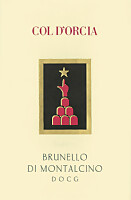
|
|
Brunello di Montalcino 2015 |
|
| Col d'Orcia (Tuscany, Italy) | |
 Sangiovese Sangiovese | |
| Price: € 30.00 | Score: |
 Brilliant ruby red and nuances of garnet red, moderate transparency. Brilliant ruby red and nuances of garnet red, moderate transparency. Intense, clean, pleasing, refined and elegant, starts with hints of
black cherry, plum and violet followed by aromas of raspberry, blueberry,
blackberry, cocoa, tobacco, graphite, licorice, leather, mace, vanilla and
menthol. Intense, clean, pleasing, refined and elegant, starts with hints of
black cherry, plum and violet followed by aromas of raspberry, blueberry,
blackberry, cocoa, tobacco, graphite, licorice, leather, mace, vanilla and
menthol.
 Tannic attack and however balanced by alcohol, full body, intense
flavors, pleasing crispness. Tannic attack and however balanced by alcohol, full body, intense
flavors, pleasing crispness.
 Persistent finish with flavors of plum, black cherry and raspberry. Persistent finish with flavors of plum, black cherry and raspberry. 3 years in cask, at least 12 months in bottle. 3 years in cask, at least 12 months in bottle. |
|
 Game, Roasted meat, Braised and stewed meat, Hard cheese Game, Roasted meat, Braised and stewed meat, Hard cheese |
|
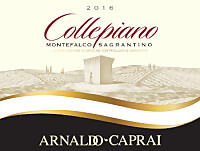
|
|
Montefalco Sagrantino Collepiano 2016 |
|
| Arnaldo Caprai (Umbria, Italy) | |
 Sagrantino Sagrantino | |
| Price: € 25.00 | Score: |
 Deep ruby red and nuances of ruby red, little transparency. Deep ruby red and nuances of ruby red, little transparency. Intense, clean, pleasing, refined and elegant, starts with hints of
blackberry, plum and violet followed by aromas of black cherry, blueberry,
peony, tobacco, chocolate, leather, mace, pink pepper, cinnamon, face
powder and vanilla. Intense, clean, pleasing, refined and elegant, starts with hints of
blackberry, plum and violet followed by aromas of black cherry, blueberry,
peony, tobacco, chocolate, leather, mace, pink pepper, cinnamon, face
powder and vanilla.
 Tannic attack and however balanced by alcohol, full body, intense
flavors, agreeable. Tannic attack and however balanced by alcohol, full body, intense
flavors, agreeable.
 Very persistent finish with long flavors of blackberry, black cherry
and plum. Very persistent finish with long flavors of blackberry, black cherry
and plum.
 22 months in barrique, 6 months in bottle. 22 months in barrique, 6 months in bottle. |
|
 Game, Roasted meat, Braised and stewed meat, Hard cheese Game, Roasted meat, Braised and stewed meat, Hard cheese |
|
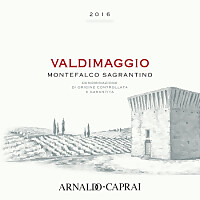
|
|
Montefalco Sagrantino Valdimaggio 2016 |
|
| Arnaldo Caprai (Umbria, Italy) | |
 Sagrantino Sagrantino | |
| Price: € 34.00 | Score: |
 Deep ruby red and nuances of garnet red, little transparency. Deep ruby red and nuances of garnet red, little transparency. Intense, clean, pleasing, refined and elegant, starts with hints of
blackberry, plum and black cherry followed by aromas of violet, blueberry,
iris, chocolate, graphite, tobacco, leather, mace, licorice, vanilla and
menthol. Intense, clean, pleasing, refined and elegant, starts with hints of
blackberry, plum and black cherry followed by aromas of violet, blueberry,
iris, chocolate, graphite, tobacco, leather, mace, licorice, vanilla and
menthol.
 Tannic attack and however balanced by alcohol, full body, intense
flavors, agreeable. Tannic attack and however balanced by alcohol, full body, intense
flavors, agreeable.
 Very persistent finish with long flavors of blackberry, plum and black
cherry. Very persistent finish with long flavors of blackberry, plum and black
cherry.
 24 months in barrique, at least 8 months in bottle. 24 months in barrique, at least 8 months in bottle. |
|
 Game, Stewed and braised meat, Roasted meat, Hard cheese Game, Stewed and braised meat, Roasted meat, Hard cheese |
|
News |
|
In this section are published news and information about events concerning the world of wine and food. Whoever is interested in publishing this kind of information can send us a mail to our address.
|
AquavitaeReview of Grappa, Distillates and Brandy |
|
|
||||||||||||
Wine Guide ParadeFebruary 2021
|
| |||||||
Privacy Policy | |||||||


| Copyright © 2002-2024 Antonello Biancalana, DiWineTaste - All rights reserved |
| All rights reserved under international copyright conventions. No part of this publication and of this WEB site may be
reproduced or utilized in any form or by any means, electronic or mechanical, without permission in writing from DiWineTaste. |